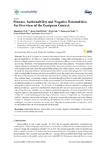Mostrar o rexistro simple do ítem
Finance, Sustainability and Negative Externalities: An Overview of the European Context
| dc.contributor.author | Ziolo, Magdalena | |
| dc.contributor.author | Filipiak, Beata Zofia | |
| dc.contributor.author | Bak, Iwona | |
| dc.contributor.author | Cheba, Katarzyna | |
| dc.contributor.author | Tîrca, Diana Mihaela | |
| dc.contributor.author | Novo-Corti, Isabel | |
| dc.date.accessioned | 2019-08-09T08:16:44Z | |
| dc.date.available | 2019-08-09T08:16:44Z | |
| dc.date.issued | 2019 | |
| dc.identifier.citation | Ziolo, M., Filipiak, B.Z., Bak, I., Cheba, K., Tîrca, D.M. and Novo-Corti, I. (2019). Finance, Sustainability and Negative Externalities. An Overview of the European Context. Sustentanibility, 11 (15), 1-35 | es_ES |
| dc.identifier.uri | http://hdl.handle.net/2183/23664 | |
| dc.description.abstract | [Abstract]: The goal of the paper is to examine the relation between finance and sustainability, with a special emphasis on the impact of negative externalities. Sustainable development as a concept aims to mitigate negative externalities. Conventional finance offers no room for the environment and society. Therefore, three-dimensional sustainable finance has appeared. This paper is the first original attempt to examine the relationship between: financial, economic, environmental and social development indicators from the sustainability perspective, with a special focus on externalities. To study the disparities between the European Union (EU) countries belonging to the OECD in the field of sustainable development and sustainable finance, the multi-criteria taxonomy was used. The basis of the analyses was the indicators transformed according to the relative taxonomy method. The database, based on Eurostat, contains indicators describing pillars of sustainable development such as: economic (12 indicators), social (28), environmental (7) and sustainable finance (16). The study analyses the sample of 23 countries in 2007, 2013 and 2016. The results confirm a positive relationship among the analysed indicators. On the basis of 62 statistical features selected according to the statistical methods, 7 groups of countries were obtained in 2007 and 2013 and 8 groups in 2016. In the case of Scandinavian countries, one can observe a permanent separation of economic growth from its negative impact on the natural environment. Such dependencies are no longer so obvious in the case of other EU countries belonging to the Organization for Economic Cooperation and Development (OECD). Therefore, attention should be paid to the most economically developed countries in Western rankings in the case of economic, social and very often also financial results correspond to much worse results in the case of environmental development. | es_ES |
| dc.language.iso | eng | es_ES |
| dc.publisher | MDPI | es_ES |
| dc.relation.uri | https://doi.org/10.3390/su11154249 | |
| dc.rights | Atribución 4.0 Internacional | es_ES |
| dc.rights.uri | https://creativecommons.org/licenses/by/4.0/deed.es | * |
| dc.subject | Sustainable finance | es_ES |
| dc.subject | Sustainable development | es_ES |
| dc.subject | Negative externalities | es_ES |
| dc.subject | Environmental economics | es_ES |
| dc.subject | Sustainability | es_ES |
| dc.subject | Taxonomy | es_ES |
| dc.title | Finance, Sustainability and Negative Externalities: An Overview of the European Context | es_ES |
| dc.type | info:eu-repo/semantics/article | es_ES |
| dc.rights.access | info:eu-repo/semantics/openAccess | es_ES |
| UDC.journalTitle | Sustainibility | es_ES |
| UDC.volume | 11 | es_ES |
| UDC.issue | 15 | es_ES |
| UDC.startPage | 1 | es_ES |
| UDC.endPage | 35 | es_ES |
Ficheiros no ítem
Este ítem aparece na(s) seguinte(s) colección(s)
-
II - Artigos [583]






